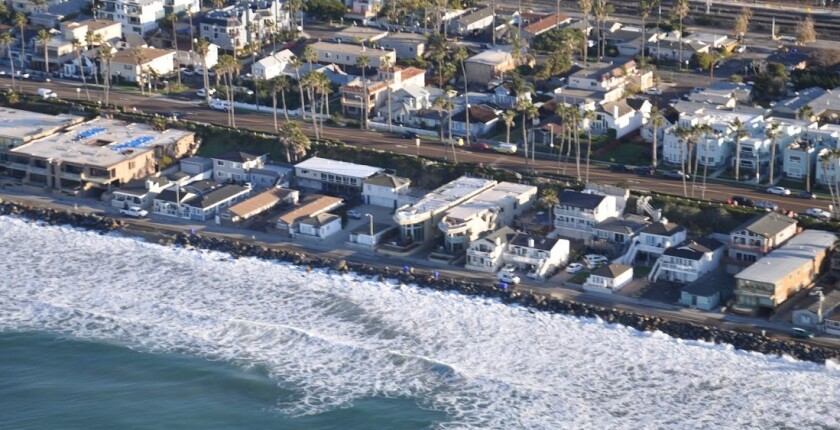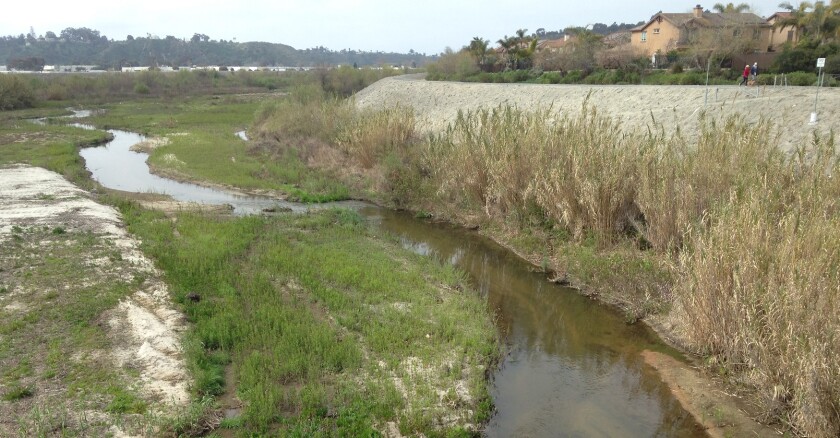
Posted on March 18, 2020
Flood-control work would benefit homes, beache
OCEANSIDE — Oceanside without sand would be like Yosemite without Half Dome or Niagra Falls without the water.
The problem is, Oceanside’s sand keeps disappearing. Coastal erosion is eating away the city’s beaches at an increasing pace.
The sandy shore where people pitched their tents and parked their cars decades ago, as historical photos show, is now down to a narrow strip of rocks in many places.
Beaches are shrinking all along coastal San Diego County. In Oceanside, that’s especially troubling because, as the city’s name implies, tourism and the sunny Southern California lifestyle are undeniably linked to the sand.
Like many coastal cities, Oceanside looks to the federal government for help. The U.S. Army Corps of Engineers maintains critical waterways such as harbors and rivers to keep them navigable, and protects and restores the nation’s beaches.
But the sand-replenishment projects overseen by the Corps are bogged down in bureaucracy, a source of frustration for city officials.
The city periodically sends a team of people to Washington, D.C. to meet with federal officials and discuss a host of local issues. This year, like most, sand was high on Oceanside’s list.
“We have a handful of Corps projects,” said Councilman Ryan Keim, who made the trip in February with the Oceanside city manager, the public works director and the water utilities director.
Harbor dredging is one thing the Corps can be counted on almost every year.
The federal government hires a contractor to dredge the mouth of the harbor, usually in the spring, to keep it open and safe for boating. The sand is pumped onto beaches south of the harbor to keep them wide and attractive to tourists, day-trippers and surfers.
However, the harbor sand only goes so far. Most years, the fresh coat only reaches the municipal pier. Ocean currents may carry some sand south of the pier, but the lower two-thirds of the city’s shore remains narrow and rocky.

(Courtesy photo)
Oceanside has been looking at two other projects for decades that could help beef up the bare beaches.
One is the long-sought San Luis Rey River flood-control project. If completed, it would protect homes along the river and provide more sand for the beaches.
“The beach gets a lot of attention, as it should, but the flood control is important, too,” Keim said.
Deepening the river channel also would save hundreds of homeowners along the river the $1,000 a year or more they pay in flood insurance premiums.
The Corps of Engineers was ready to start construction in 2016 and again in 2017, but both times, federal officials had trouble obtaining the required regional permits and the excavation never began.
Since then, the project has been on hold.
Corps of Engineers spokesman Jay Field in Los Angeles said Thursday that the San Luis Rey River is “still an active project,” but that the only current activity is mowing of the channel by the city. The city usually mows the channel in the fall to keep it clear for storm runoff, but there’s been no progress on deepening the channel.
“We are very frustrated,” Keim said. “I want to get this stuff done. I feel we’ve been neglected by the Army Corps.”
City officials are working with the Corps of Engineers to complete a “post authorization change report” that will assess what remains to be done to finish the project, said Oceanside Public Works Director Kiel Koger.
Each year brings changes to the river channel. More vegetation grows in the project area, storms move sediment downstream, and erosion affects the levees along the bank. All those things need to be reassessed before work can resume.
“Corps district staff told me recently they hope to have it completed by late April or May at the latest,” Koger said.
The report will evaluate the increased costs for sediment removal, geotechnical studies, levee inspections and repairs, endangered species monitoring and mitigation, and other expenses.
“The project can’t start up again until more funding is allocated,” Koger said.
 The San Luis Rey River, looking south from the Foussat Road bridge.
The San Luis Rey River, looking south from the Foussat Road bridge.
(Phil Diehl)
The work was expected to cost $5.3 million in 2017, and the city was to pay 25 percent of the costs. The Corps signed a contract with the Northern California company Steelhead Constructors Inc. to remove 210,000 cubic yards of sand and sediment from about one mile of the riverbed from above the bridge at Foussat Road to below the bridge at Benet Road.
Clean sand from the excavation was to be trucked to the beach, and any sediment not fit for the beach was to be dumped at the city’s El Corazon property.
Oceanside’s third sand-related project is the Corps of Engineers’ “shoreline feasibility study.”
The shoreline study would examine the causes of the city’s coastal erosion and outline possible long-term solutions. Completion of the study could help the city qualify for additional replenishment projects.
A similar shoreline study completed for Encinitas and Solana Beach enabled those cities to qualify for a 50-year sand replenishment project that was allocated $87 million in 2016 as part of the federal Water Resources Development Act. An additional $400,000 was allocated in February for the planning, engineering and design of the project. In all, the two-city effort was recently estimated to cost $174 million over the 50 years.
The Corps launched the Oceanside study in 2016 with plans to finish it in three years at a cost of less than $2 million, funded entirely by the federal government.
However, in 2017, the Corps halted the study and demanded Oceanside contribute as much as $1 million to finish it. Since then, the effort has gone nowhere.
Oceanside Mayor Peter Weiss recently renewed a request for the Corps of Engineers to finish both the shoreline study and the river flood-control project in a March 10 letter to Los Angeles District commander Col. Aaron Barta.
“Oceanside has a long and well-documented history of beach erosion resulting from the government’s construction of Camp Pendleton harbor … in 1942,” Weiss said in the letter.
Oceanside’s harbor, built in the 1960s, shares its entrance with the Camp Pendleton harbor.
Previous studies have shown the rock jetty at the entrance to the two harbors obstructs the prevailing ocean currents and catches sand that otherwise would flow south. Beaches north of the jetty are wide and sandy, while south of the jetty they are sand-starved.
Harbor dredging is the one job the Corps has consistently completed for Oceanside.
The annual spring cleaning began last week and this time the Corps expects to dredge about 400,000 cubic yards, almost twice the usual amount.
Also this year the contractor, Manson Construction, plans to pipe more of the sand from the harbor onto beaches south of the pier.
“They had to begin placement north of the pier, starting near the condos, so they could build up the surface to support the pipe transporting the material,” said Field, the Corps spokesman, on Monday. After a few days, weather permitting, the pipes were expected to reach south of the pier.
Weather permitting, this year’s dredging should be completed by mid-April, Field said.
Most years, the dredging is completed by Memorial Day weekend, which is the unofficial start of the summer tourist season. This year, Memorial Day is May 25.
Source: sandiegouniontribune





